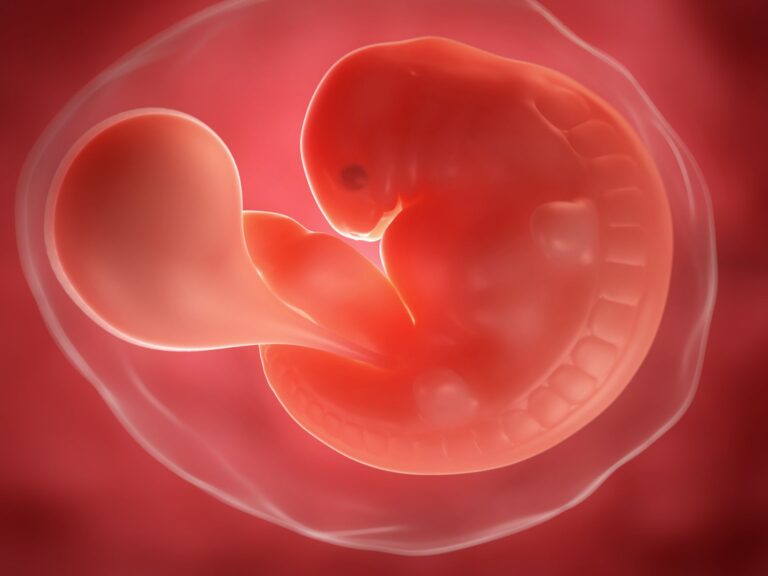6 weeks pregnant: Pregnancy Symptoms & Baby Development
Read time: 4 minutes
6 weeks pregnant is how many months?
Month 2 (Trimester 1)
Baby development at 6 weeks
Your baby’s neural tube is closing¹ and their heart is pumping blood around their tadpole-like body.
Folic acid
Discover why folic acid is so important at this time.
Morning sickness
Learn how to ease the queasiness of morning sickness that may have started.
Baby development at 6 weeks

How big is my baby? And, what does my baby look like?
Although only measuring around 2–4mm from the crown of their head to their bottom2, your baby has grown significantly in size since last week. In this 6th week of pregnancy they have a tadpole-like appearance, but with the tiny buds of their arms and legs developing, this won’t last long3. Once the limbs grow longer, your baby is still measured from head to bottom because the legs are often bent and difficult to gauge.
Your baby’s heart, which is no bigger than a poppy seed3, is now beating at around 110 beats per minute, while the beginnings of their digestive tract are starting to form4.
Pregnancy at 6 weeks (first trimester)
Body changes
While it’s common to be bloated at 6 weeks pregnant, it’s unlikely that you’ll look pregnant yet or see any signs of a pregnancy belly.

Pregnancy symptoms at 6 weeks
Early pregnancy symptoms vary from person to person. At 6 weeks, you may experience any of the following signs of pregnancy, or no symptoms at all:
Breast tenderness
Your breasts may become larger and feel sore. You may also find your nipples stick out more than usual and darken in colour as your body begins to prepare for breastfeeding.
Tiredness and fatigue
During the first 12 weeks, hormonal changes can leave you feeling tired or exhausted.
Nausea and vomiting
Morning sickness affects up to 80% of mums-to-be in the first trimester6. It can strike at any time of the day or night and varies from mild nausea to sickness throughout the day.
Bloating and gas
The pregnancy hormone progesterone slows down your digestion which can lead to bloating and excess gas.
Cramping or bleeding
Light cramping and spotting are common in the early stages of pregnancy8,9. If the pain becomes severe (stronger than period cramps) or if bleeding becomes heavy, you should talk to your GP.
Frequent urination
Frequent trips to the bathroom are one of the most common symptoms of early pregnancy, as your growing uterus begins to put pressure on your bladder, and also because your circulation can double even at this early stage meaning you will produce more urine. Do make sure that you drink enough water to keep up with these changes, or you can feel dizzy and faint.
Mood swings
Pregnancy hormones, oestrogen and progesterone, soar during the first 12 weeks of pregnancy10, affecting how you’re feeling emotionally. Get plenty of rest and light exercise to keep you feeling like yourself.
Feeling nauseous?
Your pregnancy hormones are building by the time you’re 6 weeks pregnant, which can often lead to nausea. These tips may help you keep nausea at bay:
Eating little and often may give some relief.
Many mums say a dry cracker in the morning before getting out of bed can help to settle the stomach.
Some mums-to-be find that ginger can help to ease pregnancy-related nausea and vomiting11. Making black tea with fresh ginger and lemon can be helpful, as can fennel tea. Keep sipping small amounts every few minutes, as dehydration can make the nausea worse. There are medications to help, especially if you suffer with repeated vomiting – do see your GP to get help.
Even if you can’t tolerate your usual amount of food, try to stick to a healthy diet – it will give you and your baby the nutrients you both need.
Focus on folic acid
The Department of Health recommends taking a daily folic acid supplement for the first 12 weeks of pregnancy12.
The naturally occurring food source of folic acid is called folate. It is present in green, leafy vegetables, lentils, chickpeas and kidney beans, and folic acid is also added to some breads and breakfast cereals. However, because your needs are so high during this stage of pregnancy, it is difficult to get enough from food sources alone. This is why a supplement is recommended.
Check that your prenatal multivitamin contains the recommended 400mcg of folic acid you need.
If you find out you’re pregnant and haven’t been taking folic acid supplements or a prenatal multivitamin containing folic acid, don’t worry: simply start taking them straight away and carry on until you reach 12 weeks.
The
Science
Behind
FOLIC ACID
Powered by Nutricia
This important nutrient supports the development of the neural tube, which is already closing to form your baby’s spine and nervous system. Taking 400 micrograms (mcg) of folic acid as a supplement is the best way to reduce the risk of neural tube defects, such as spina bifida.
Some women take a higher dose of folic acid. Why?
If your risk of having a baby with spina bifida is higher than normal, you will be advised to take a daily dose of 5 milligrams (mg) of folic acid. This is higher than usual and it will need to be prescribed by a doctor. You may be advised to take an increased dose if:
- you have had a previous pregnancy affected by spina bifida
- you or your partner have spina bifida
- you are taking certain medications for epilepsy
- you have coeliac disease or diabetes
- your BMI is 30 or more
- Cyou have sickle-cell anaemia or thalassaemia; the higher dose of folic acid will also help to prevent and treat anaemia if you are in this situation.
- you have had bariatric surgery
